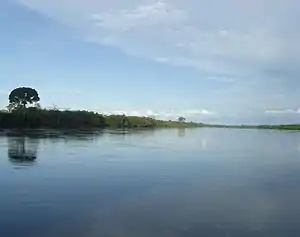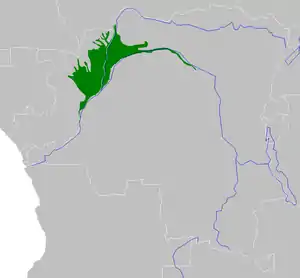Western Congolian swamp forests
The Western Congolian swamp forests are an ecoregion of the Republic of the Congo and Democratic Republic of the Congo. Together with the adjacent Eastern Congolian swamp forests, it forms one of the largest continuous areas of freshwater swamp forest in the world. It is a flooded forest with a high canopy, dense undergrowth and has a muddy floor. It has not been disturbed very much by outside influences and so remains largely pristine as getting through this forest is called "almost impossible".[2]
| Western Congolian swamp forests | |
|---|---|
 Congo River near Kisangani | |
 Map of the Western Congolian swamp forests | |
| Ecology | |
| Realm | Afrotropical |
| Biome | Tropical and subtropical moist broadleaf forests |
| Borders | Eastern Congolian swamp forests, Northeast Congolian lowland forests, Northwest Congolian lowland forests and Western Congolian forest-savanna mosaic |
| Geography | |
| Area | 128,060 km2 (49,440 sq mi) |
| Countries | Democratic Republic of the Congo and Republic of the Congo |
| Conservation | |
| Conservation status | relatively stable |
| Protected | 52,662 km² (41%)[1] |
Flora
The ecoregion contains areas of permanently flooded swamp forest, seasonally flooded swamp forest, and flooded grassland. The permanently flooded swamp forests are home to extensive stands of Raphia palm. Trees in the seasonally flooded forests include species of Garcinia and Manilkara.
Fauna
The ecoregion is home to the endangered western lowland gorilla (Gorilla gorilla gorilla) and African forest elephant (Loxodonta cyclotis).
See also
References
- Eric Dinerstein, David Olson, et al. (2017). An Ecoregion-Based Approach to Protecting Half the Terrestrial Realm, BioScience, Volume 67, Issue 6, June 2017, Pages 534–545; Supplemental material 2 table S1b.
- World Wildlife Fund, ed. (2001). "Western Congolian swamp forests". WildWorld Ecoregion Profile. National Geographic Society. Archived from the original on 2010-03-08. Retrieved July 10, 2011.
External links
- "Western Conglolian swamp forests". Terrestrial Ecoregions. World Wildlife Fund.